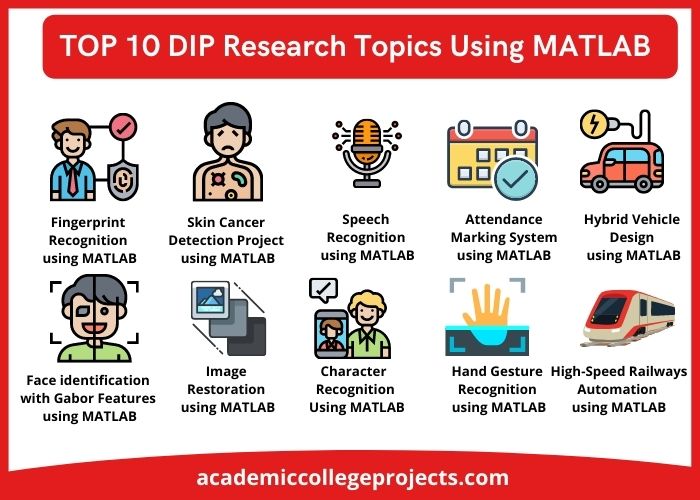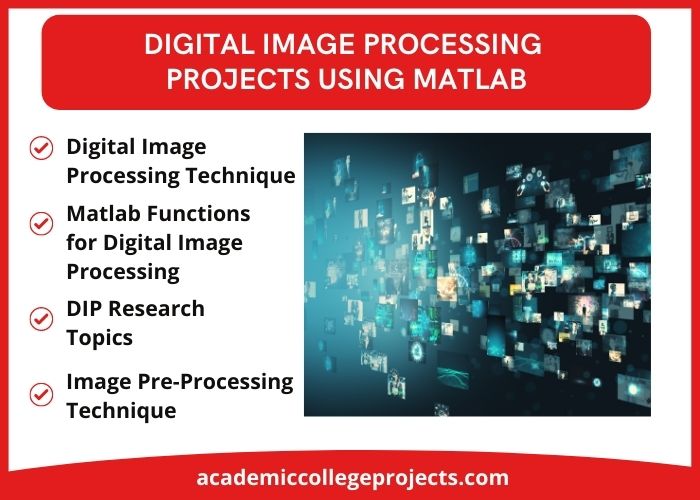On this page, research scholars can get to know about developing their Digital Image Processing Projects Using Matlab functions for various processing techniques. A digital image is the composition of a finite number of picture elements called pixels. Also, it is represented as 2D functions with f(x, y) spatial coordinates in the form of discrete mathematical representation. Majorly, the Image is made up of any of the following,
- 4D and above hypervoxels – Represents hyper-volume elements
- 3D voxels – Represents volume features
- 2D pixels – Represents picture features
In general, digital image processing is the method of manipulating the digital images in the digital system for generating digitalized enhanced images. It is also one of the main applications of signal processing for working with 2D video or images. Here, we have given you the typical types of practice involved in image processing.
How Images Processed?
- Image processing is done by a computerized machine where human views the outcome is known as automatic analysis.
- The processing of Images done by both machines and humans is known as semi-automatic analysis.
- The processing of Images done by humans is known as manual analysis.
Digital Image Processing Techniques
As a matter of fact, there is a large volume of image processing methods for thorough image investigation. But, these methods are suitable enough for small-range tasks. Still, there is no common large range of tasks image processing methods are created, which is more capable than manual Image analyzing. Here, we have specified some important approaches for Image pre-processing followed by image analysis methods for your awareness.
Image Pre-Processing Techniques
- Image Enhancement
- Contrast Enhancement
- Linear Normalization
- Fuzzy Logic-based Histogram Equalization
- Image Segmentation
- Color Histogram-based
- Multiple Atlas-based
- Region Growing-based
- Graph Cut / Theory-based
- Statistical Shape Model-based
- Deformable Model-based (curve or surface)
- Image De-noising
- Morphological Filter
- Adaptive based Median Filter
- Improved Wavelet Transform
- Linear / Non-linear Wiener Filter
- Weighted Median Filter (WMF)
Image Analysis Methods
- Spectral Imaging
- Median / Average Filtering
- 8 bit or 24-bit Color Conversions
- Morphological Processing
- 2D Spatial Hilbert Transform
- Geometric Image Transformations
- Discrete Wavelet Transforms
- Contrast and Edge Enhancement
- Region-of-Interest (RoI) Detection
- Fast Fourier Transforms (FFTs)
- Gaussian Low and High Pass Filtering
- Finite Impulse Response (FIR) Filters
- Image Arithmetic and Logic Operations
- Histogram Equalization and Contrast Adjustment
As a matter of fact, image processing is bestowed with different procedures to process the Image for improving the image understanding and representation. Each approach has its functionalities to go through the Image in multiple aspects. Also, these techniques have so many benefits in applying real-world applications. Below, we have showcased the advantages of DIP techniques.
Why choose Digital Image Processing Techniques?
- Image Enhancement for better interoperability
- Noise Reduction for imperfection removal
- Deblurring artifacts for distortion and blur effect removal
- Contrast Enhancement for improving low dynamics
- Image segmentation for identifying the structure and homogeneous regions
- Image Registration for incorporating prior knowledge
- Feature Classification for same pattern recognition
- Sub-image matching for image retrieval
- Shape Description for geometric image analysis
- And many more
Moreover, we have also listed the evolution of digital image processing techniques based on different generations in terms of Region, boundary detection, and pixel classification.
- Third Generation
- Region-based – Appearance and Shape Models, Land Surface Coupling and Fuzzy Rule-based
- Pixel Classification – Multi-Dimensional Rule-based and Multi-Atlas based
- Second Generation
- Region-based – Graph-based Search and Deformable Shape
- Boundary Following – Spatial Multi-resolution, Shortest Path, Graph Convolutional Neural Networks (GCN) and Object Locating
- Pixel Classification – Geometric Pattern Recognition, K-means / Fuzzy Clustering, Deep Neural Networks, Multiple / High Resolution
- First Generation
- Region-based – Statistics or Gradient-based Region Growing
- Boundary Following – Heuristic Search and Edge detection.
- Pixel Classification – Pixel Intensity / Threshold
Further, the impact of image processing has widely expanded in many research fields. Since all the fields mainly rely on informatics science and technology. So, ultimately image processing techniques are incorporated in different fields based on their requirements. And, some of them are given below,
- Image Segmentation
- 3D Human Pose Estimation
- Optical Flow Estimation
- Video Motion Tracking
- Single-Particle Motion Detection
- Real-Time 2D / 3D Object Recognition
- Medical Image Analysis and Visualization
Next, we can see the functions used for implementing Digital Image Processing Projects Using Matlab. Besides, these methods play a major role in manipulating Images based on specific needs like feature extraction, selection, and more functions for dip projects using python.
Matlab Functions for Digital Image Processing
- Automated Model Selection
- fitcauto – Automatic classification model selection along with optimized hyperparameters
- Feature Selection
- fscmrmr – Using minimum redundancy maximum relevance (MRMR) algorithm, rank the features for classification
- fscchi2 – Based on chi-square tests, rank the univariate feature for classification
- fscnca – Depends on neighborhood component analysis, select the feature for classification
- predictorImportance – Predictor importance assessment for classification tree
- relief -Predictor importance Rank by RReliefF or ReliefF algorithm
- predictorImportance – Predictor importance evaluation for classification (decision trees)
- oobPermutedPredictorImportance – Predictor importance approximation through
- out-of-bag predictor observations permutation for classification (random forest)
- sequentialfs – Based on the custom standard, select the sequential feature
- Feature Engineering
- gencfeatures – For the purpose of classification, do the automated feature engineering
- describe – Define the features that are generated
- transform – Based on the generated features, create new data
- Classification Performance Evaluation
- perfcurve – Describe the classifier model using receiver operating characteristic (ROC) curve or other performance curves
- confusionmat – Confusion matrix calculation for assessing classification performance
- confusionchart – Confusion matrix chart creation for evaluating classification
- Model Accuracy Comparison Tests
- testckfold – Perform repeated cross-validation for predictive accuracies comparison between two classification models
- testcholdout – predictive accuracies comparison between two classification models
- Hyperparameter Optimization
- optimizableVariable – For optimizing bayesopt and others, utilize variable description
- hyperparameters – For optimizing the fit method, use variable descriptions
- bayesopt – Apply Bayesian optimization algorithm to select optimal hyperparameters in machine learning
For example, if we are working with image classification problems, several models support accurate results in classifying digital Images. And, some of the best models for Image Classification are InceptionV3, NASNet, Xception, VGG19, DenseNet, VGG16, MobileNet, and ResNet50. In addition, let’s see the Matlab functions which support different kinds of SVM for Image classification,
- Multiclass ECOC
- fitcecoc – Fit the optimal multiclass models for SVM classifier and others
- templateECOC – learner template of ECOC model
- predict – Apply multiclass based error-correcting output codes (ECOC) model for classifying observations
- Binary SVM
- predict – Support vector machine classifier for Classify observations
- fitSVMPosterior – Fit the optimal value for posterior probabilities
- fitcsvm – One-class binary classification is done by SVM classifier
- templateSVM – Template of SVM model
- Binary Kernel Classification
- predict – Estimation of labels for Gaussian kernel classification model
- fitckernel – Fit the optimal value for Gaussian kernel classification model based on random feature
- templateKernel – Template of Kernel model
- Binary Linear Classification
- classificationPartitionedLinear – Cross-validation aided linear model for high-dimensional learning data in binary classification
- classificationLinear – A linear model for high-dimensional learning data in binary classification
- Multiclass ECOC
- compactClassificationECOC – Compact based multiclass model for SVM classifier and others
- classificationECOC – Multiclass model for SVM and other classifiers
- classificationPartitionedKernelECOC – Kernel ECOC model using Cross-validation for multiclass classification
- classificationPartitionedLinearECOC – Cross-validation based linear ECOC model for high-dimensional learning data in multiclass classification
- classificationPartitionedECOC – Cross-validation supported multiclass ECOC model for SVM classifier and others
- Binary Linear Classification
- predict – Linear models for estimating labels in binary classification
- templateLinear – Linear template for classification learner
- fitclinear – Fit linear model used for high-dimensional learning in binary classification
- Binary SVM
- compactClassificationSVM – compact SVM for one-class (binary) classification
- classificationPartitionedModel – classification model depends on cross-validation
- classificationSVM – SVM classifier for both one-class classification and binary classification
- Binary Kernel Classification
- classificationPartitionedKernel – Binary kernel classification model based on cross validation
- classificationKernel – Random feature for gaussian kernel classification model
We have listed out the important latest research dip thesis topics for Digital Image Processing Projects Using Matlab for your benefit. Further, if you want to know more unique research ideas, then make a bond with us.
Recent Digital Image Processing Using Matlab Research Topics
- 3D Modeling, Printing, and Displaying
- Integration and Assessment of HIS, CIS and RIS
- Medical Imaging Ontologies and Visual Vocabularies
- SIIM Workflow Initiative in Medicine (SWIM)
- Broadening of Enterprise Imaging informatics
- Construction of Medical Multimedia Storage System
- Digital Imaging and Communications in Medicine DICOM
- Clinical Image assisted Electronic Patient Health Records
- Content-based Medical Image Retrieval using ML Approaches
- Efficient Digital Medical Image Processing (capturing, interpreting, presenting, transmitting, and storing)
We are sure to help you in every research activities starting from topic selection to thesis/dissertation submission. To a great extent, we also give paper publication support with an assurance of fast acceptance. Reach us to know more information about digital image processing projects using matlab. Our Expert panel team will guide you to implement DIP based projects.



